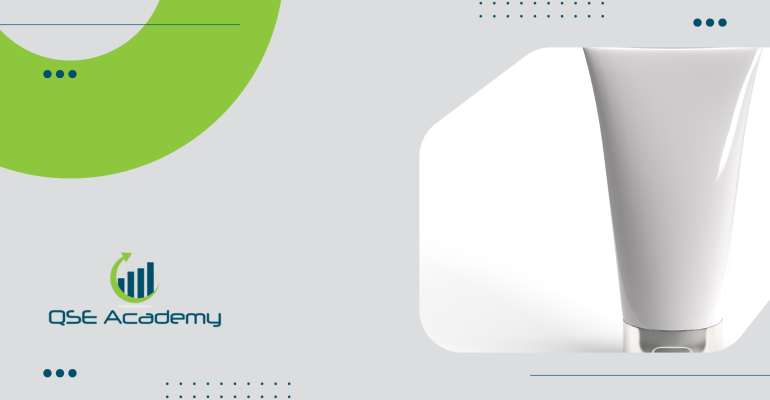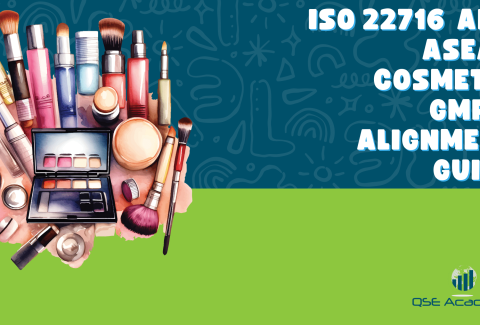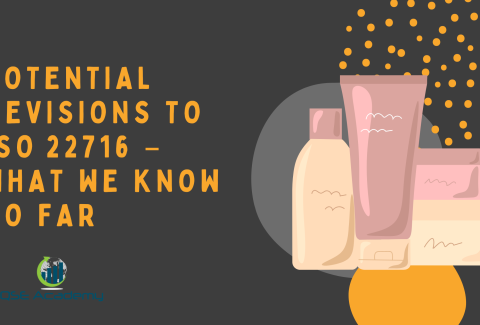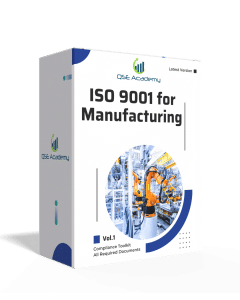ISO 22716 for Cosmetics: Industry Use Cases
Last Updated on October 24, 2025 by Hafsa J.
ISO 22716 for Cosmetics: Industry Use Cases
In the cosmetics world, trust is everything. Customers need to feel confident that the products they’re using—whether it’s a moisturizer, lipstick, or sunscreen—are safe, consistent, and high-quality.
That’s where ISO 22716 for cosmetics becomes essential. This international standard is like a practical guide for Good Manufacturing Practices (GMP), but specifically designed for the cosmetics industry. It covers the entire journey, from making and storing products to quality control and shipping.
Why is this important? Well, cosmetics are always under a microscope.
Following ISO 22716 doesn’t just help companies meet regulations; it improves product quality, reduces risks, and builds credibility locally and internationally.
If you’re launching a new product, this standard is like your trusty roadmap, ensuring every batch meets the same high standards. Let’s break down how it works in real life.
How ISO 22716 for Cosmetics Shapes Product Development
Creating new products can be thrilling, but without the right controls in place, it can get chaotic fast. ISO 22716 for cosmetics ensures structure and reliability in the product development process. For starters, it helps standardize methods so that testing and scaling are consistent.
Every step is documented—whether it’s ingredient sourcing, formulation tweaks, or test results—so you can trace everything back if needed. And, it ensures that suppliers are up to par, so your raw materials come from high-quality, trusted sources.
Imagine you’re working on a new sunscreen. With ISO 22716, every ingredient is tested, every formula change is recorded, and you only work with vetted suppliers. This approach helps minimize errors and makes the launch much smoother.
When it comes to formulation, precision is key. ISO 22716 ensures you get it right every time by focusing on raw material testing, maintaining clean and controlled production environments, and keeping batch consistency.
Let’s say you’re making a face cream. This standard ensures the same mixing time, temperature, and ingredient order are followed each time, so every jar feels and works just like the last.
Manufacturing Excellence: The Role of ISO 22716 for Cosmetics
When it comes to manufacturing, ISO 22716 for cosmetics provides a comprehensive blueprint for safe and efficient practices. It ensures facilities are clean and well-maintained, equipment is regularly serviced, and raw materials are handled properly to stay fresh and safe.
Every step of production is carefully documented, and personnel hygiene is strictly enforced—think gloves, hairnets, and protective clothing. For instance, if you’re producing lipstick, the standard ensures mixing equipment is cleaned between batches, ingredients are measured precisely, and every action is recorded to maintain consistency.
Consistency and safety are the cornerstones of good manufacturing, and ISO 22716 provides the framework for both.
It standardizes procedures so every production step is repeated the same way.
In-process testing—like checking pH or running microbial tests—helps catch issues early, and traceability links raw materials to finished products, making it easy to address problems if they arise.
For example, a serum made under these guidelines ensures every bottle has the correct concentration of active ingredients and passes safety tests before hitting store shelves.
Supply Chain Best Practices Under ISO 22716 for Cosmetics
Your supply chain is just as critical as your production process, and ISO 22716 ensures your suppliers meet the same high standards. This includes vetting suppliers, setting clear quality expectations for materials, and testing raw ingredients when they arrive.
Formal agreements define who’s responsible for maintaining quality. Why does this matter? Because if a supplier falls short, it can lead to contaminated products, recalls, or regulatory issues. ISO 22716 helps you avoid those pitfalls.
Traceability is another big focus. With batch numbering and centralized records, the standard makes it easy to track products from raw materials to the store shelf. Imagine a batch of foundations has an issue.
With good traceability, you can pinpoint the problem’s source, check the records, and resolve it efficiently.
How ISO 22716 is Integrated into Global GMP Regulations
ISO 22716 for cosmetics is more than a standalone standard; it’s an integral part of the global GMP framework. As the cosmetics industry operates in an increasingly interconnected world, companies must navigate a variety of regional GMP requirements. ISO 22716 helps bridge these differences by providing a universally recognized set of guidelines that harmonize practices across borders.
For example:
- In the European Union, compliance with ISO 22716 is mandatory under the Cosmetic Regulation (EC) No 1223/2009, ensuring product safety and consumer protection.
- In Asia, countries like Japan and China have their own GMP requirements, but many manufacturers align with ISO 22716 to meet international export demands.
- In the United States, while GMP requirements are outlined in the FDA’s regulations, ISO 22716 is often used as a complementary standard to demonstrate adherence to high-quality practices.
This integration makes ISO 22716 a valuable tool for companies operating globally, simplifying compliance with diverse regulatory environments.
Regional Variations in GMP Regulations and ISO 22716’s Role in Harmonization
GMP regulations can vary significantly from one region to another, reflecting local priorities and regulatory frameworks. For instance:
- The European Union emphasizes stringent documentation and traceability.
- In North America, the focus may include robust safety testing and labeling compliance.
- Asian markets often integrate cultural and traditional product considerations into their GMP requirements.
ISO 22716 acts as a unifying force, providing a consistent framework that helps companies manage these regional variations. By aligning with ISO 22716, manufacturers can streamline their operations, ensuring compliance in multiple markets without needing to reinvent processes for each region.
Comparison of ISO 22716 with Other GMP Standards
While ISO 22716 focuses specifically on cosmetics, it shares principles with other GMP standards like ISO 9001 (Quality Management Systems) and ISO 14001 (Environmental Management Systems). Understanding these differences and overlaps can clarify the unique role of ISO 22716:
- ISO 22716: Targets the cosmetics industry, emphasizing clean manufacturing environments, product safety, and consumer protection. It includes guidelines for production, quality control, and documentation tailored to cosmetics.
- ISO 9001: Focuses on general quality management principles applicable across industries. It emphasizes customer satisfaction, continual improvement, and process efficiency.
- ISO 14001: Addresses environmental management, helping companies minimize their environmental impact while complying with regulations.
ISO 22716 complements these standards by adding a layer of industry-specific requirements for cosmetics, ensuring safety and quality while maintaining alignment with broader quality and environmental management goals.
Real-World Use Cases in the Cosmetics Industry
Many successful brands have leveraged ISO 22716 for cosmetics to meet strict regulatory requirements and build consumer trust. Take a skincare brand trying to break into the European market.
They needed to meet strict EU regulations, so they conducted a gap analysis, upgraded their facilities with better air filtration, and trained their staff on GMP principles. The result? They achieved ISO 22716 certification and boosted their international sales by 40%.
Or consider a startup focused on natural cosmetics. They wanted to establish credibility with big retailers, so they developed clear production procedures, improved traceability with digital tools, and secured contracts with major retailers—all while avoiding costly recalls.
Adapting ISO 22716 for Global Markets
ISO 22716 is a strong foundation for tackling regional regulations. In the EU, it’s mandatory under Cosmetic Regulation 1223/2009. In the U.S., it aligns with FDA guidelines, while in Asia-Pacific countries like Japan and South Korea, it simplifies compliance.
It’s also often a requirement for entering markets in the Middle East.
Combining ISO 22716 with other standards, like ISO 9001 for quality management or ISO 14001 for environmental responsibility, can further strengthen your operations. If you’re targeting niche markets, certifications like Halal or Organic Standards pair well with ISO 22716.
In a nutshell, ISO 22716 ensures safety, quality, and consistency at every stage of cosmetic production. It’s not just about following the rules—it’s about building trust, improving operations, and unlocking global opportunities.
Real-world examples show how adopting this standard can lead to greater market success. Ready to incorporate ISO 22716 for cosmetics into your business strategy and ensure global compliance? Let’s get started!

make ISO standards less intimidating and more approachable for everyone.
Whether it’s ISO 9001, ISO 22000, or the cosmetics-focused ISO 22716, I’ve spent my career
turning complex jargon into clear, actionable steps that businesses can actually use.
I’m not here to call myself an expert—I prefer “enthusiast” because I truly love what I do.
There’s something incredibly rewarding about helping people navigate food safety and quality management systems
in a way that feels simple, practical, and even enjoyable.
When I’m not writing about standards, you’ll probably find me playing Piano 🎹, connecting with people, or diving into my next big project💫.
I’m an engineer specialized in the food and agricultural industry
I have a Master’s in QHSE management and over 12 years of experience as a Quality Manager
I’ve helped more than 15 companies implement ISO 9001, ISO 22000, ISO 22716, GMP, and other standards
My clients include food producers, cosmetics manufacturers, laboratories, and service companies
I believe quality systems should be simple, useful, and efficient.
Looking for More Resources on ISO 22716?
If you found this article helpful, explore our premium resources designed to help you achieve ISO 22716 certification efficiently:
- Complete Documentation Package for ISO/IEC 22716 2017: Get all the essential templates and documents you need for fast, easy implementation.
- Online Course on ISO/IEC 22716 2017 : Enroll in our comprehensive training to master the key concepts and practical steps toward certification.
- ISO/IEC 22716 2017 Checklist: Download our detailed checklist to ensure you’ve covered every step of the process.
These resources are tailored to meet your needs and ensure a smooth certification journey. Explore them today and get one step closer to success!











